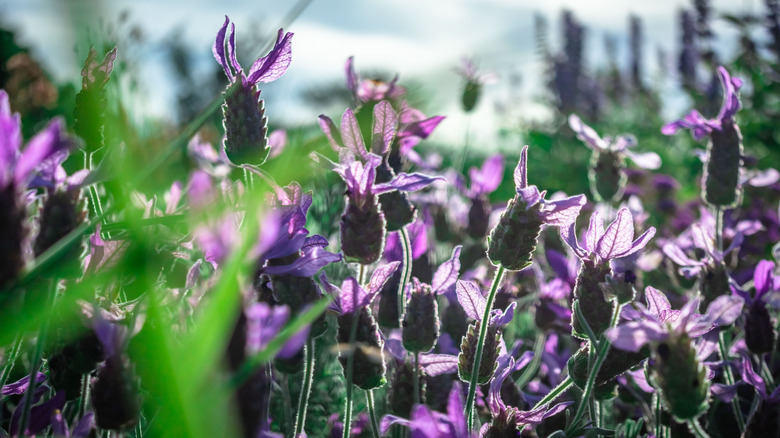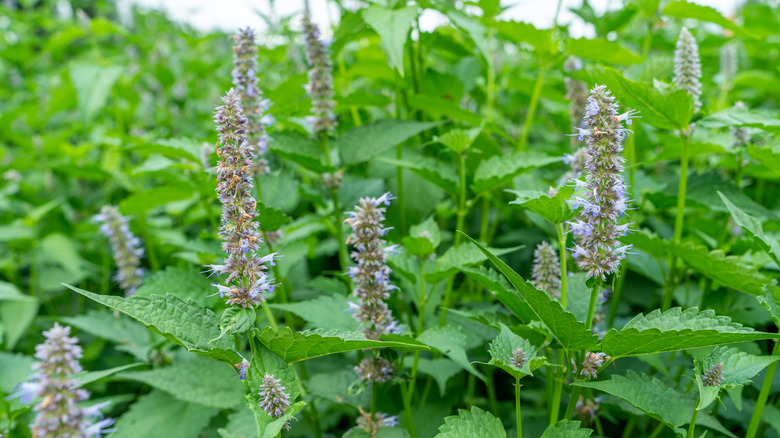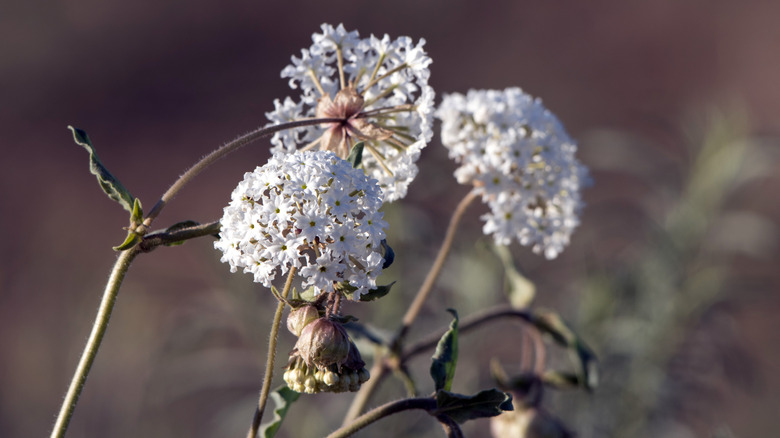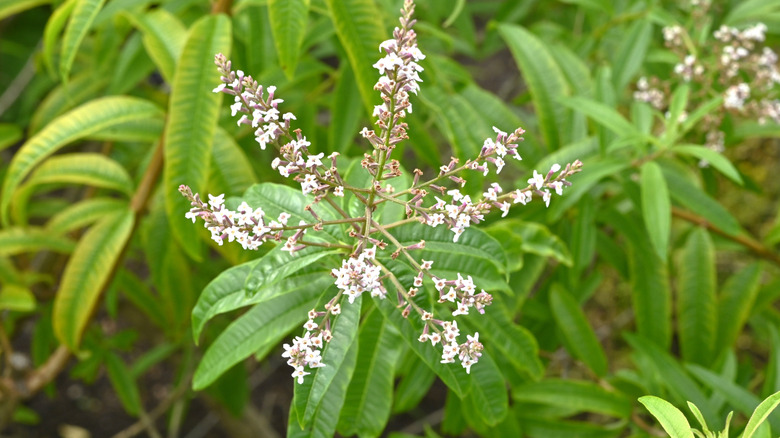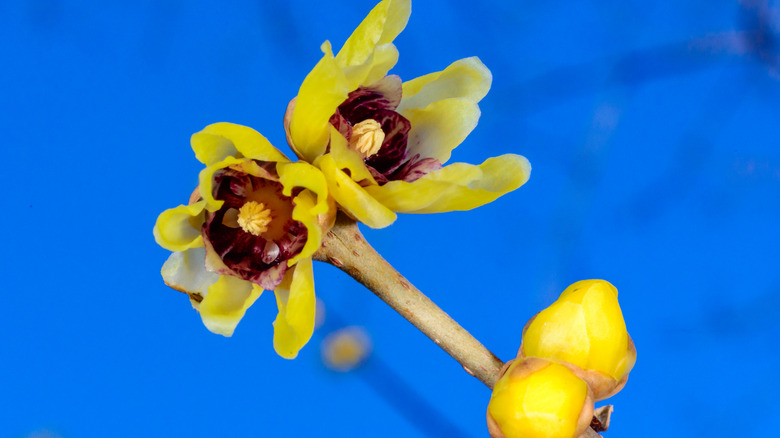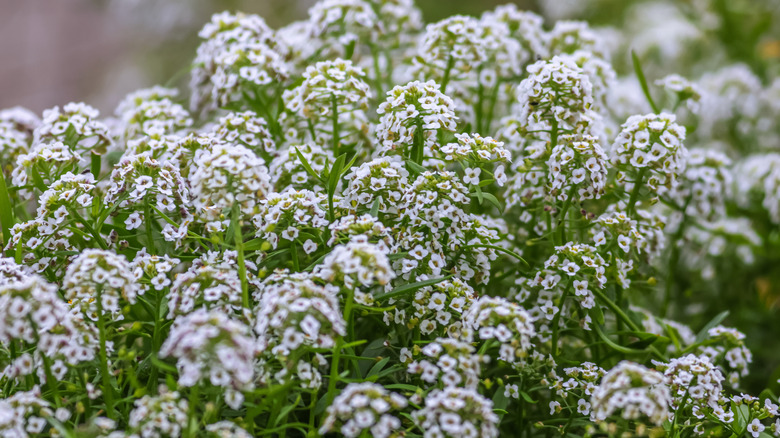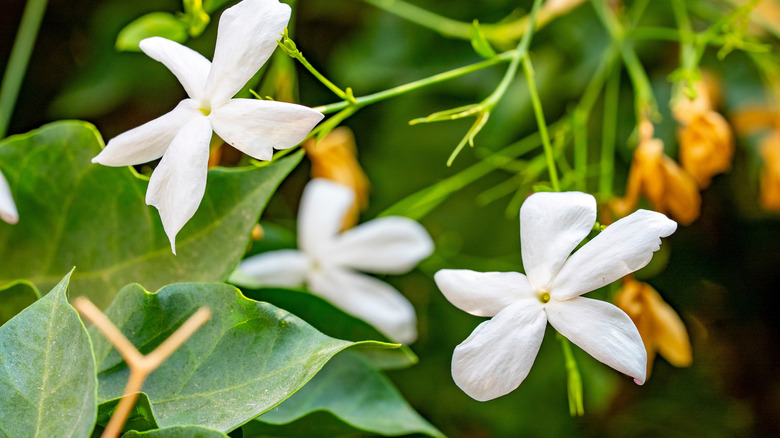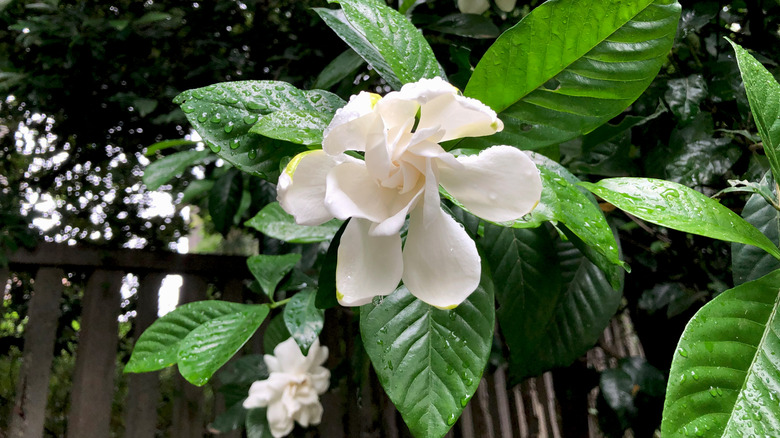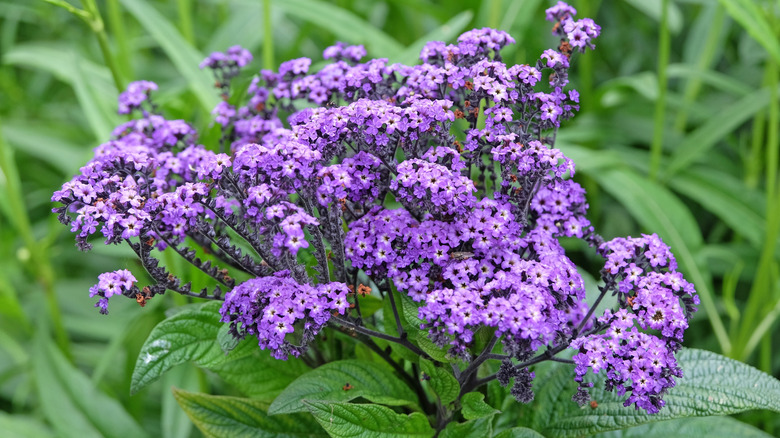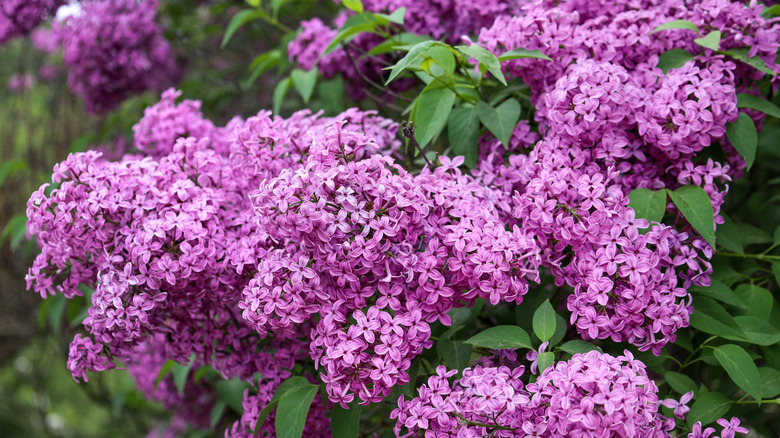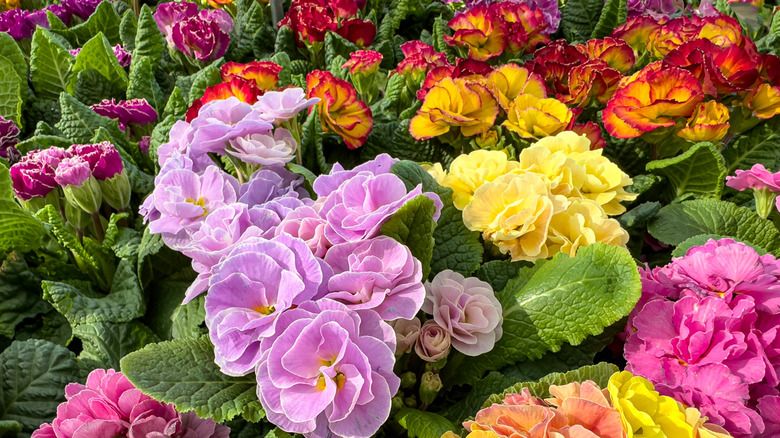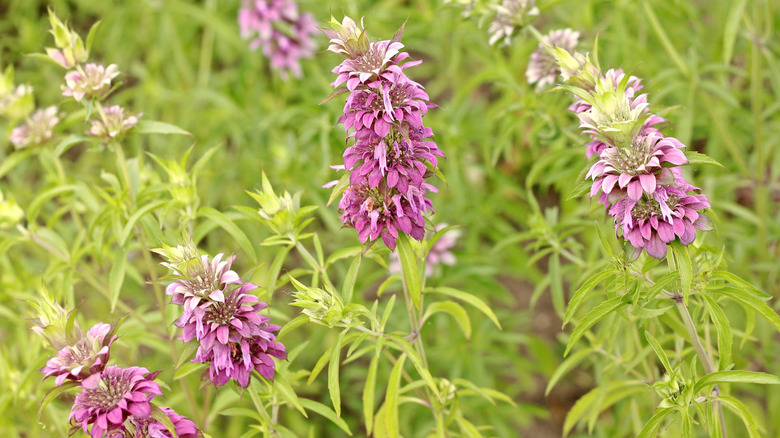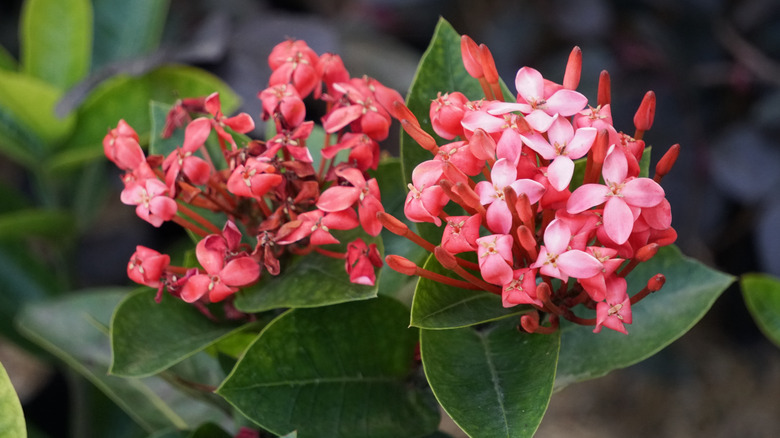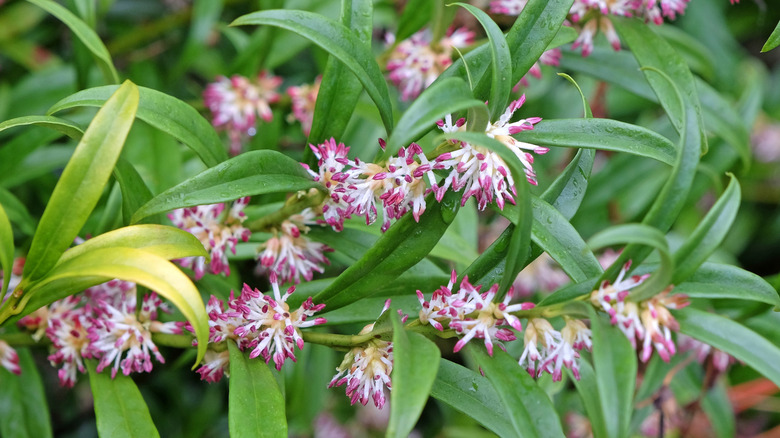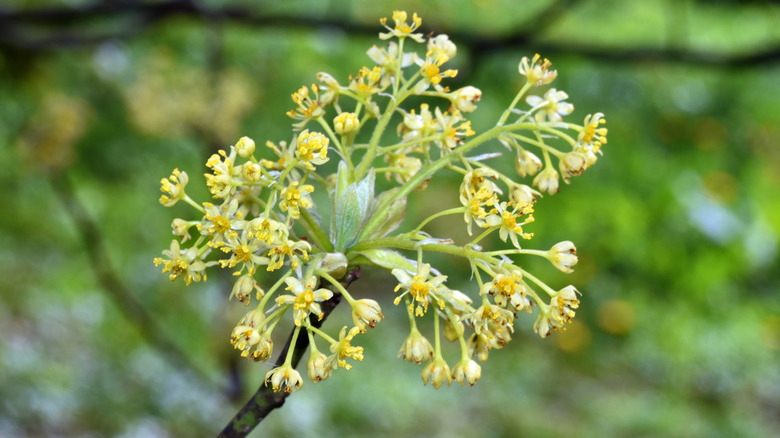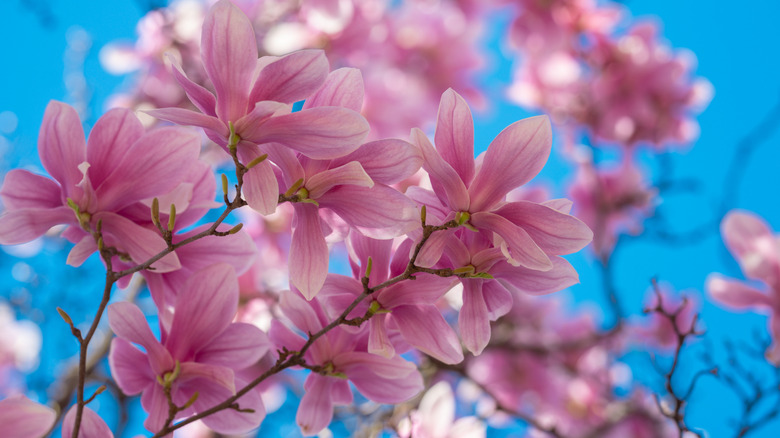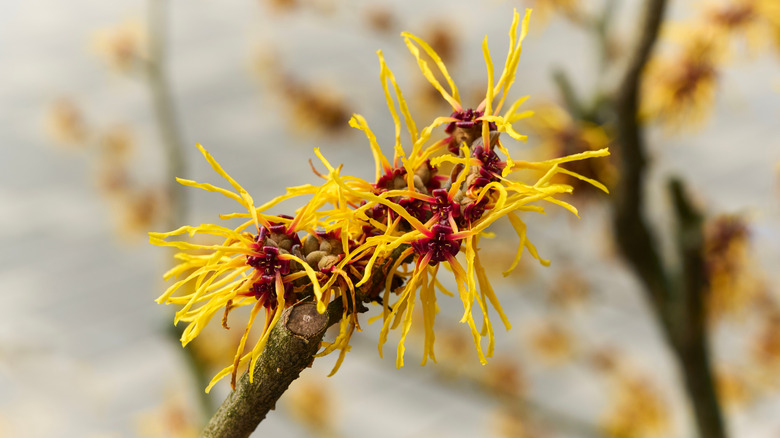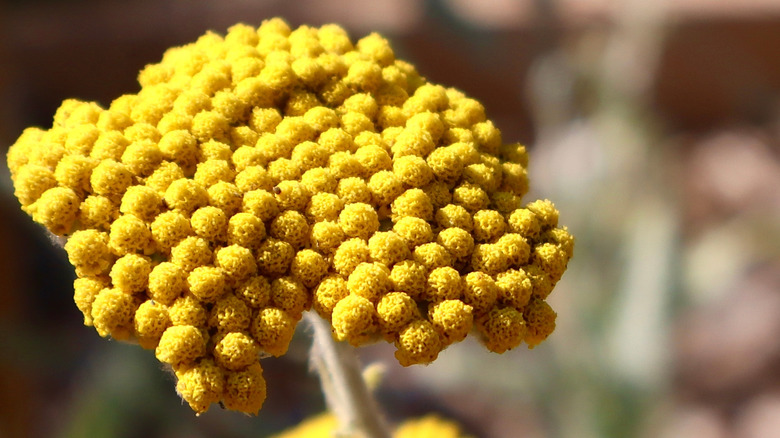18 Plants That Can Cover Up Unpleasant Odors In Your Yard Or Garden
Unpleasant odors can creep into even the most beautiful yard, whether it's from compost piles, traffic, or the neighbor's stinky trash cans. While air fresheners and sprays can't do much to help outside, nature itself has a few solutions: plants. Certain shrubs, herbs, and flowers can release fragrant oils that mask bad smells, leaving your garden fresh and happy.
Welcome to the world of the "sensory garden," a planting scheme that plans for aesthetics and sensory delights. Some focus on plants that are nice to touch, others on ones that smell as nice as they look, and some like to mix it up and add as many sensory details as possible. The trick is knowing which plants work best, which is where we come in. From climbing vines to show-stopping shrubs, we've found 18 different plants that cover a wide array of growing conditions and seasons, so that you can have good scents all year round. Plus, we'll explain the best ways to keep your plants happy and healthy, so that you get the benefits of a beautiful garden that just happens to be fragrant, too.
French lavender (Lavandula stoechas)
French lavender (Lavandula stoechas) is one of the most delightful scents you can add to your yard. The herbal-floral oils released from its flowers and stems don't just smell good, they actively overpower less-pleasant odors, like pet waste, traffic fumes, or compost. Because the scent carries easily, lavender works especially well in large or open areas where you need coverage across more ground. Plus, its fragrance is considered calming to pets and people, turning a smelly corner of the garden into a relaxing retreat for all.
Plant French lavender in your garden that has full sun, hot and dry conditions, and soil that's well-draining and ideally slightly-alkaline. Overwatering is the fastest way to kill it, so lean toward a reduced watering routine and avoid heavily mulching around the roots. L. stoechas blooms throughout spring and summer, so plant it along borders or near patios where its fragrance can act like a natural shield against whatever nasty smells happen to drift over the border fence.
Hummingbird mint (Agastache)
Hummingbird mint (Agastache) earns its place in a sensory garden thanks to its sweet, minty, or anise-like fragrance, depending on the variety. Its foliage releases their scent when brushed or warmed by the sun, masking unpleasant odors without being overpowering. That makes it useful in mixed borders or beds, where it masks odors from mulch, damp corners, or compost piles, while adding fragrance that's softer than heavy bloomers like jasmine.
Different varieties layer in different notes: Agastache rupestris and A. Poquito orange 'TNAGAPO' have a strong licorice or anise fragrance, while Agastache 'Astello indigo' and 'Firebird' lean toward minty notes. Others, like the hot pink 'Tutti Frutti' hybridm have a lemony, citrus scent. All thrive in full sun and well-draining soil, and once established, are drought tolerant. Planting multiple cultivars together not only extends bloom time into late summer, but also blends scents, creating a more complex aromatic backdrop that enhances both fragrance and resilience.
Fragrant sand verbena (Abronia fragrans)
Fragrant sand verbena (Abronia fragrans) lives up to its name with clusters of white, lavender, or pink blooms that smell sweet and jasmine-like. What sets it apart is timing: This fragrant perennial opens its flowers in the late afternoon, perfuming the air all evening, then closes in the morning. That rhythm makes it ideal for masking odors that drift in after sunset, whether from grilling, smoke, or lingering pet smells. With fragrance that carries through the night, it can transform patios or decks into fresh-smelling retreats even when the air is still.
Fragrant sand verbena thrives in full sun, well-draining sandy or loamy soil, and room to spread. Its sticky, hairy stems help it tolerate arid conditions, and it's drought tolerant once established. Plant it along patios, decks, or outdoor seating areas for the biggest impact, where its night-blooming fragrance doubles as both a sensory delight and a natural odor shield.
Lemon verbena (Aloysia citriodora)
Lemon verbena (Aloysia citriodora) delivers one of the sharpest, cleanest fragrances you can add to a garden. Its lemony aroma comes from its narrow green leaves, which release fragrance strongest between mid-summer and fall when brushed or warmed by the sun. That crisp scent cuts through musty corners, compost piles, or pet areas, giving outdoor spaces a fresh, citrusy lift. Because it releases scent on contact, it's especially effective planted along walkways or outdoor sitting areas where you'll interact with it often. As a bonus, its leaves are edible and used for teas and desserts, as well as homemade potpourri.
Lemon verbena thrives in full sun and well-draining soil. It can get up to 8 feel tall and wide if you let it, so keep it pruned to promote a more bushier shape. If you live somewhere that gets fairly harsh winters or below USDA Hardiness Zone 8, you'll need to grow it in containers, so it can be brought indoors before frost.
Wintersweet (Chimonanthus praecox)
Wintersweet (Chimonanthus praecox) is unusual in that it blooms when few other plants do. Its translucent yellow flowers open in the heart of winter, releasing a spicy-sweet fragrance that cuts through the cold, masking odors like wood smoke, damp leaves, or musty corners of the yard. That makes wintersweet especially valuable in a sensory garden, where it bridges the gap between autumn and spring bloomers.
C. praecox grows best in full sun to partial shade and prefers well-draining soil with some organic matter. It can reach 10 to 13 feet tall if left unpruned, so give it plenty of space or trim it lightly after flowering to shape. Plant it near entryways, patios, or walkways where its winter blooms can be appreciated up close, both for their fragrance and for their bright flowers that can make even the dullest of winter days feel a little more cheerful.
Sweet alyssum (Lobularia maritima)
Sweet alyssum (Lobularia maritima) may look delicate with its tiny clusters of white blooms, but it packs a surprising punch with a sweet, honey-like scent. In the garden, sweet alyssum's aroma works well to mask less pleasant smells, from musty corners near mulch piles to lingering odors along walkways. It forms a low, dense mat, making it handy for tucking into borders or edging beds where you want a fragrant "ground-level" odor-masking plant.
The best place to plant sweet alyssum is a spot that has full sun to partial shade and well-draining soil, spreading into mounds that bloom from spring until frost in cooler regions. In hotter summers, it may pause flowering to conserve energy, but a quick trim and some afternoon shade usually revive it. Its drought tolerance makes it low-maintenance, and when planted en masse, sweet alyssum creates a soft carpet of blooms that both freshens the air and fills gaps between taller plants.
Jasmine (Jasminum officinale)
Jasmine (Jasminum officinale)is famous for its intoxicating fragrance, with a single vine strong enough to perfume practically an entire garden. Its sweet aroma is most intense in the evenings, masking traffic fumes, smoke, or other lingering odors that drift through at night. Trained over a fence, pergola, or trellis, jasmine creates both a visual screen and a scented barrier, transforming utilitarian structures into fragrant garden features. For patios or entryways, it can be a first line of defense against unwanted smells, while also setting a calming, romantic atmosphere.
J. officinale thrives in full sun to partial shade and prefers moist, well-draining soil enriched with organic matter, though it will tolerate average conditions. It blooms through the summer, but in colder climates it can be tricky to overwinter. In those cases, confederate jasmine (Trachelospermum jasminoides) can be a good J. officinale substitute, since it tolerates cooler conditions better than its cousin.
Gardenia (Gardenia jasminoides)
Gardenia (Gardenia jasminoides) is one of the most recognizable fragrant plants, thanks to its creamy white blooms and lush, dark green foliage. When it blooms in the summer and fall, its perfume is rich, heady, and strong enough to mask unpleasant odors, making it ideal for patios, entryways, or yards where lingering smells are a problem. Because the flowers release their scent most heavily in the warm months, a blooming gardenia can transform outdoor seating areas into naturally perfumed retreats, especially during summer evenings when the fragrance carries on the breeze.
Gardenias thrive in bright, indirect sunlight or partial shade and prefer consistently moist, well-draining, acidic soil. Keep in mind they can be finicky, because they dislike sudden changes in temperature and need humidity to really thrive. Plant them near seating areas or windows, so their scent can be enjoyed both outdoors and in.
Heliotrope (Heliotropium arborescens)
Heliotrope (Heliotropium arborescens) is sometimes called the "cherry pie plant," due to many thinking it smells like baked cherry pie, though the scent has also been compared to vanilla. The fragrance is strongest in the heat of summer. That sweet scent easily overpowers musty or compost odors and brings a sweet, pastry-like note to patios or garden edges. Older cultivars are especially fragrant, making them a great choice if you want a strong perfume to mask less pleasant smells in outdoor living spaces.
Heliotrope prefers full sun with some afternoon protection in very hot regions, and thrives in moist, well-draining soil. It can be grown in containers or garden beds, and in cooler climates, many gardeners treat it as an annual, since it struggles with frost. Plant it near patios, walkways, or open windows, where its fragrance can drift through the air and give a surprise "pick-me-up" aroma as you pass by.
Lilac (Syringa vulgaris)
Lilac (Syringa vulgaris) is a springtime showstopper, producing dense clusters of purple, pink, or white flowers with a fragrance strong enough to perfume an entire yard. That sweet, pungent scent easily masks less pleasant odors, from nearby trash bins to traffic fumes, making lilacs especially useful when planted along property lines. Because they bloom in mid-to-late spring, lilacs provide one of the earliest seasonal boosts of fragrance, ensuring your garden smells fresh even before summer flowers arrive.
Lilacs thrive in full sun and prefer well-draining, slightly alkaline soil. They need a long winter chill for buds to mature, which makes them best suited for colder climates. As large, multi-stemmed shrubs, they're ideal for creating hedges or privacy screens that double as natural odor barriers. Prune right after flowering to encourage strong blooms for the next season and to maintain their big, bushy shape.
Primrose (Prima vulgaris)
Primrose (Primula vulgaris)brings one of the earliest bursts of fragrance each spring, offering a light, sweet scent that pushes back against the damp, musty odors left from winter. Its cheerful, pale blossoms brighten shady corners or damp garden edges, releasing just enough perfume to refresh areas prone to mildew or poor air movement. Because it blooms as early as April, primrose fills a seasonal gap when few other flowers are fragrant, making it amazing in sensory gardens designed for year-round appeal.
Primroses grow best in partial shade with humus-rich, moist, but well-draining soil. They like consistently damp conditions, so regular watering is important, especially during dry spells. Primroses are hardy in USDA Hardiness Zones 4 through 8, making them one of the more hardy, aromatic perennials. With just a little care, they return year after year, adding both freshness and fragrance to the early spring garden.
Lemon beebalm (Monarda citriodora)
Lemon beebalm (Monarda citriodora)emits a sharp, citrusy fragrance from its foliage when crushed or brushed against, making it especially effective near compost bins, damp corners, or areas with earthy odors. Its stacked purple-pink flower whorls attract bees, butterflies, and hummingbirds, creating the rare combination of odor control and pollinator activity in a single plant. Because the lemon scent is uplifting, rather than heavy, it layers well into mixed beds without overwhelming nearby blooms.
M. citriodora thrives in full sun and rocky, sandy, or loamy soils that drain well. It blooms from spring into mid-summer, often self-seeding to form colonies if left to spread. For best use, plant lemon beebalm near patios, compost piles, or along borders where its fresh fragrance can do double duty as a odor-masker and a pollinator magnet. Its edible leaves can even be brewed into a refreshing lemon tea.
Tea olive (Osmanthus fragrans)
The tea olive (Osmanthus fragrans) is a like a fragrance powerhouse. Its small, inconspicuous flowers release an intense, sweet, apricot-like scent in early spring and again in the fall, giving your yard two rounds of odor-masking coverage each year. The perfume is strong enough to mask lingering smells from nearby roads or trash bins, and because it carries well, tea olive is especially effective when planted as a hedge or border shrub where it doubles as both a screen and a natural air freshener.
O. fragrans grows best in full sun to partial shade and prefers moist, well-draining soil, though it can handle heavier clay once established. In southern climates, it will need some afternoon shade to help protect its foliage from scorching. Plant it near entryways, patios, or fences to make the most of its sweet scent and odor-masking power.
Sweet box (Sarcococca confusa)
Sweet box (Sarcococca confusa) might have a "confusing" name (pun intended), but its fragrance is anything but. This evergreen shrub produces tiny, delicate flowers in the middle of winter, releasing a sweet, vanilla-like perfume when little else is blooming. That scent is strong enough to mask lingering cold-weather odors like damp soil, leaf litter, or even the smell of nearby trash bins. Because it flowers on bare stems, the fragrance often comes as a surprise, drifting through shaded corners of the yard when you least expect it.
S. confusa thrives in full to partial shade and prefers moist, well-draining soil, though it tolerates a wide range of soil types and pH levels. Hardy in USDA Zones 6 through 9, it's a great low-maintenance choice for shady borders, foundations, or pathways where other plants may struggle. Its glossy evergreen foliage provides year-round beauty, while its mid-winter bloom ensures you get a burst of freshness when the rest of the garden is dormant.
Sassafras (Sassafras albidum)
Sassafras (Sassafras albidum) is a native tree that adds both shade and a distinctive fragrance to the yard. All parts of the tree are aromatic: scratch the bark or crush the leaves, and you'll release a spicy, root beer–like scent that's strong enough to mask musty or smoky odors. Because it's a full-sized tree, sassafras works especially well as a background planting or natural windbreak, helping to screen odors drifting in from nearby roads or neighboring properties. Its early spring flowers also carry a light fragrance, while adding a burst of seasonal color.
Sassafras prefers well-drained, sandy, acidic soil, but adapts to other types if drainage is good. It grows in full sun to partial shade and is drought tolerant once established. This fast-growing tree can reach 30 to 60 feet tall, so give it plenty of space to spread. As a bonus, its foliage turns brilliant shades of red, orange, and yellow in fall, offering beauty along with its intoxicating scent.
Magnolia (Magnolia spp.)
Magnolia (Magnolia spp.) trees are famous for their dramatic, plate-sized blossoms and their unforgettable fragrance, which can range from sweet to citrusy, depending on the species. Their bold scent carries easily across the yard, making them particularly effective at masking large-scale odors like traffic fumes or compost piles. In late spring and early summer, magnolias become seasonal "fragrance anchors," filling outdoor spaces with perfume just as people begin spending more time outside.
Different species bring their own signature notes: M. grandiflora — aka the iconic Southern magnolia — produces large, creamy flowers with a rich, lemony-citrus scent, while M. stellata varieties feature star-shaped blooms with a lighter, sweeter fragrance. All thrive in full sun to partial shade with rich, moist, well-draining soil. Depending on the variety, magnolias can grow as towering shade trees or compact multi-stemmed shrubs, making them adaptable for a wide range of gardens.
Witch hazel (Hamamelis virginiana)
Witch hazel (Hamamelis spp.) is one of those plants that earns its keep by filling fragrance gaps when the rest of the garden is quiet. Depending on the species, it can bloom in late winter, spring, or even autumn — releasing a sweet, sometimes spicy fragrance that drifts across the yard and masks lingering cold-weather or musty odors. H. vernalis, the spring-blooming witch hazel, is especially prized for its intensely fragrant flowers that appear January through March, when little else is awake, while the U.S.-native H. virginiana shines in fall through winter, perfuming the air just as its golden leaves turn.
Witch hazel grows best in full sun to partial shade and prefers moist, well-draining soil enriched with organic matter. It's hardy, adaptable, and makes an excellent specimen shrub or border plant, with many cultivars reaching 10 to 15 feet tall. Place it near paths or patios to enjoy its ribbons of fragrant flowers up close, especially when the rest of the landscape is still bare or winding down.
Curry plant (Helichrysum italicum)
The curry plant (Helichrysum italicum) is one of the more unusual-looking perennials with silvery foliage and clusters of yellow blooms that release a spicy scent often compared to curry powder. While not the source of the spice itself, its strong fragrance lingers in warm air and can easily mask unwanted garden odors during the summer months. Used in a sensory garden, it adds both visual contrast and a bold perfume that sparks curiosity and conversation.
H. italicum thrives in full sun and well-draining, sandy or rocky soil, tolerating drought once established. It blooms throughout summer and works especially well in containers, where its scent can be concentrated in small spaces. Try positioning large pots at garden corners, patios, or entryways, so its spicy aroma acts as a natural odor-masker and focal point. As a bonus, its silvery foliage provides year-round texture, making it as useful for design as it is for fragrance.

